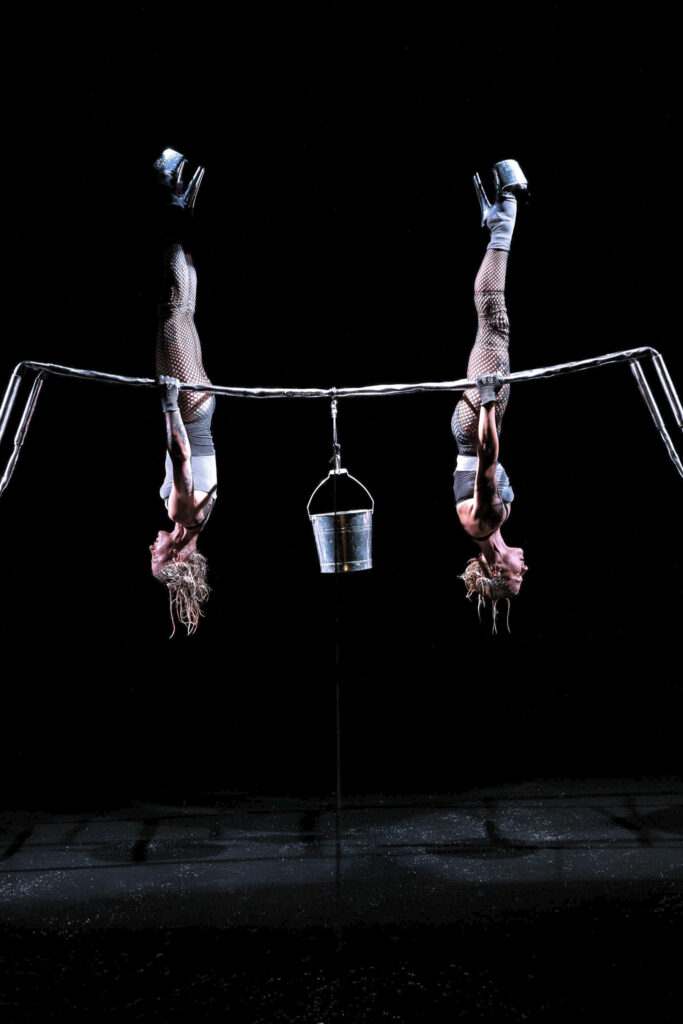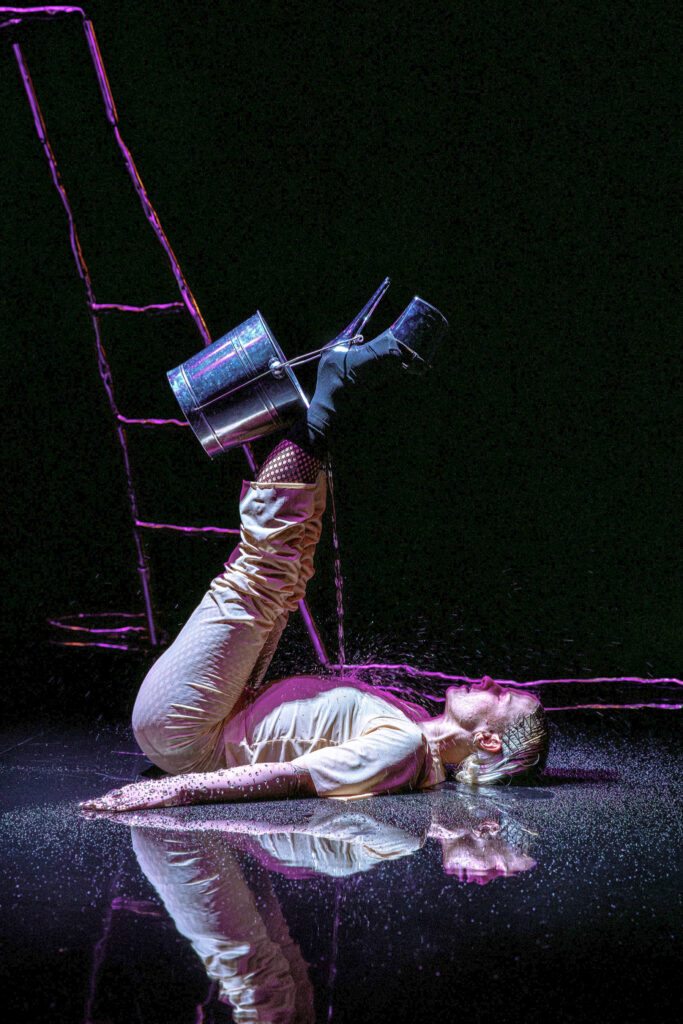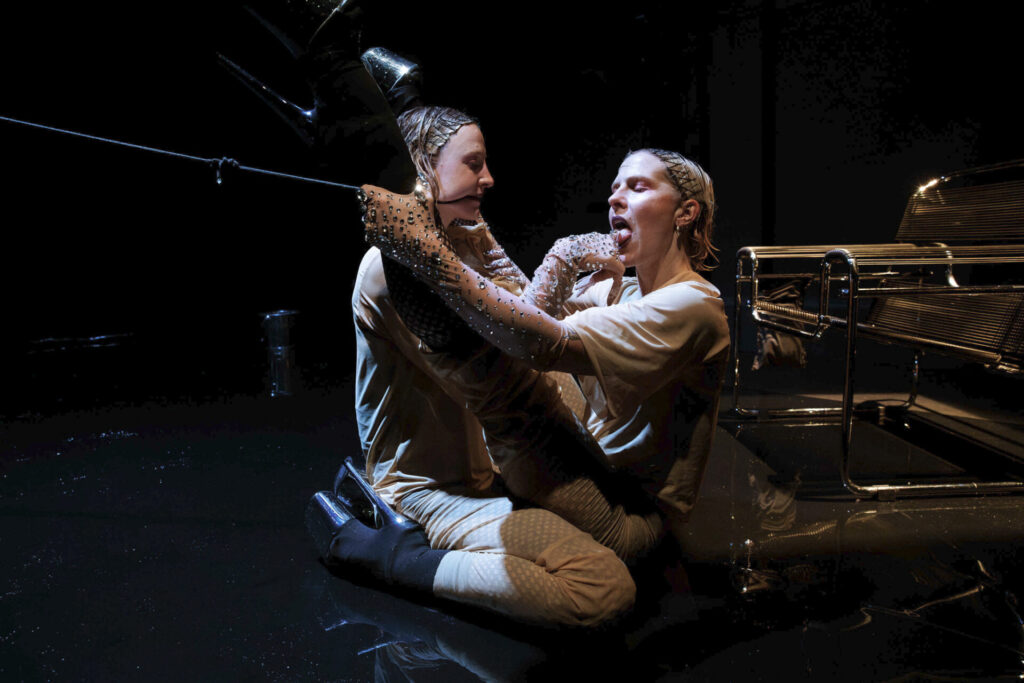Jenni Large on Choreographing Femme with WET HARD LONG

Luruwita-based artist Jenni Large uses dance, sculpture and design to create performance art that distorts our associations with sex, sexual orientation, body culture and patriarchal subservience. In 2022, Large won the Keir Choreographic People’s Choice award for WET HARD, a duet performed with dancer Amber McCartney. This salacious, mesmerising spectacle of endurance and strength saw Large and McCartney embody feminine obeisance and power. In July 2024, Large debuted the extended version of WET HARD at Melbourne’s Dancehouse, fittingly titled WET HARD LONG (WHL). I was fortunate to speak with her about this performance.
LAURA TOOBY Could you start by sharing the origin of WET HARD LONG?
JENNI LARGE Originally, the work involved a difficult set piece that ended up not fitting in the theatre. I felt stumped because material, props and costuming are really important generators for me. I prefer having something in addition to the body and my own feelings, thoughts, and emotions to start with. Something that can offer a relational narrative
At the time, I had just begun pole-dancing and discovered 8-inch pleasers. After some research and exploration, I was obsessed and I knew I had to use them. They are completely aligned with how I see my relationship to femininity, sex and sexuality.
LT Tell me more about your costumes for WHL.
JL They were designed by Michelle Boyde, and we use this tan-coloured mesh fabric that, when soaked in water, looks like dripping, shedding flesh. During the performance, 20 minutes of slow-motion movement precede a somewhat torturous scene where we virtually waterboard ourselves. During that scene, the fabric gets drenched and then clings to our bodies like soppy skin. There is an undressing and in the following section, we wear a darker costume, which is a bit cabaretesque and more form-hugging. Aspects of the choreography and our appearance transform throughout the show, from floor-bound movement to elevated/suspended movement, from dry to wet, from restrained to slippery. In all these conditions, we commit to the difficult task of wearing the pleasers. , adding visceral risk and difficulty.
LT I suppose the shoes must be central to this idea, especially since they initiated the concept.
JL Yeah, heels were originally designed by men for men but later evolved as a tool to accentuate women’s form for the male gaze. I think pleasers have been completely reclaimed by sex workers. As a symbol, they contain multiplicities and contradictions. I mostly see them as a symbol of feminine strength. However, when you wear the shoes (without a pole to support you), you feel fairly unstable and wobbly! It’s difficult to balance on them because they’re designed to be worn alongside a pole. I became obsessed with the duality of feeling powerful, bigger, beastly, feminine, and erotic, like a fucking boss, and yet I took a few careless steps and completely toppled. This feeling reflected what I wanted Wet Hard Long to speak to: the experience of femininity and all its magical and challenging contradictions, especially fragility and power and how the patriarchal ideal asks us to endure composure no matter what.


LT The obsidian silver aesthetics seem very prominent in the design of this work too. What was the reason for this?
JL Well, growing up in the 1990’s with two older brothers, I watched movies like Alien and Terminator. I remember those movies so well because the female protagonists had strong, warrior-like bodies, like Linda Hamilton. So, these defiant female characters became a strong point of reference within this boyish world. The aesthetics of these films inspired the dripping, warped metal monkey bar piece, fabricated by the incredible Jemima Lucas. The bars are twisted and banged up, and they melt into two silver, glossy puddles on the stage. Alongside the silver buckets, chrome Pleasers and rhinestone jewelled gloves, the melting metallic monkey bars felt completely aligned and were also a vital aspect of the work because they create opportunities for our bodies to suspend or be off the ground. The silver is like the melting metal in Terminator or even Alex Mack. Depicting different states of the silver—warped, solid, watery and glimmery—is another representation of the multiplicities of the feminine.
LT How mesmerising! I wish I could have seen it. Can you tell me a little more about how you choreographed movement to carry out these ideas? I am gathering that there was nothing dainty about it.
JL The use of such symbolic and specific costumes was a way to tell a story. I wanted to provoke the viewer’s preconceptions of the female body and I knew that I didn’t want to do this with the choreography alone. Different aspects of the work are designed to tell different parts of the story. For example, if the audience sees us wearing pleasers, they might imagine that we’ll dance in an erotic way or at least dance on the shoes, but we purposefully only stand vertically twice in the performance as a way to resist the images that the audience might be expecting. I am very interested in horror tropes; so exploring anticipation and tension, setting up expectations and subverting them with slow and encroaching movement makes for some visceral and intense viewing.
It was hard not to stray from this one slow-motion mode of moving. I remember during the creative development I said to Amber, “I think we’ve got to give the audience some relief,” to which she said, “Why are we going to give the audience relief? We [as women in patriarchal society] don’t get relief.” This was a really crucial moment that completely re-committed us to the gruel of this movement vocabulary and the need to push it to the extreme.
LT How else do you create this effect?
JL The choreography involves excessively elaborate ways of doing simple tasks. For example, when we waterboard ourselves, we don’t tip the bucket of water above our head with our hands; rather, we hook the heels of our 8-inch Pleasers around the handle of the bucket, suspend it with our legs and pour the water at a painfully slow rate. This excessive elaborateness became the formula for us to generate choreography. We ended up choosing not to do anything using our hands. This way, the audience understands the level of difficulty and, hopefully, the futility of it. They’re experiencing it with us and thinking, Oh my God, why are you doing that? Why are you putting yourself through that?
There is also a moment in the work where we invite an audience member to participate. It’s during a scene where Amber and I are suspending one bucket of water with a rope held in our mouths and doing some ridiculously elaborate slow-motion leg-spread choreography, nodding to tropes of fetish and kink, subservience and power. Then we invite the participant on stage to sit in a very sexy chair and hold the rope, suspending the bucket for the rest of the show. Their instruction goes something like: “When you’re asked, take the reins, endure and enjoy.” I deliberately wanted the instructions to be a little ambiguous so that the risk of audience participation was real. Without explicit instructions, they could have decided to drop the bucket as their muscles fatigued. The fascinating thing is that each participant utterly behaved themselves, subservient to the work. The way the participant responded ultimately reflects society at large.

LT Is there any resolution for them?
JL Well, without wanting to give anything away, the final image of the work is sinister, domineering and also open-ended, which felt like an important choice. The chosen participant is a male presenting person, and when they join us on stage, we become a triangulation of effort. Yes, we need men to join us in breaking down patriarchal scaffolding, and no, it won’t simply resolve in our lifetime. We need to commit to it together and endure the challenges together. There is no eruption or explosive relief at the end of this show.
LT I agree; one must only look sideways to see that the stifled conversation around gender politics can so quickly cause enmity and regression. Where do you hope to take things next?
JL Well, it has been the most wonderful collaborative experience, not just with all the incredible creatives and production team, but also with friends and family who’ve supported me throughout. I am overflowing with gratitude for everyone involved and it would be wonderful to share what has been born from this collective effort nationally and internationally. Watch this space!
LT How exciting! Jen, I can’t wait to see this happen!
JL Thank you, Laura.
LT Thank you, Jen.
Contemporary Dance You, Beauty Navigates Ideas of Scale, Movement and Horror
By Laura Tooby
RISING Returns to Melbourne with Golden Square, The Wilds, Patricia Piccinini and more
By Annabel Blue
Nuum: 'Heart Tape', a French Monastery, Tokyo and Pop Music
By Sarah Buckley
Tyde moves through the music
By Rachel Weinberg
For Volume, Jonathan Wilson Expands on the Boundaries of What an Artist Actually Is
By Rachel Weinberg
MARTIN by HUGH: A Curated Exhibition of Martin Margiela's Archive
By Annabel Blue
